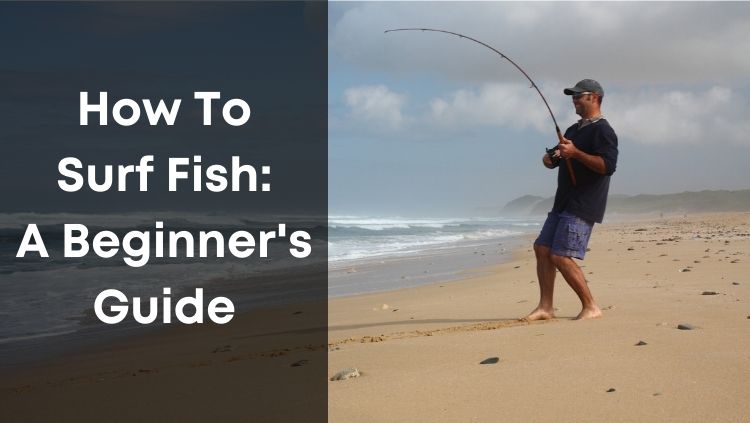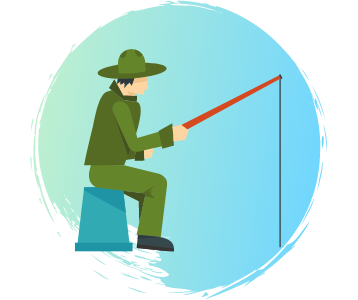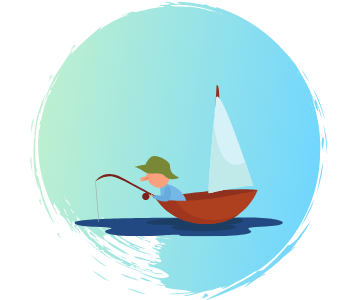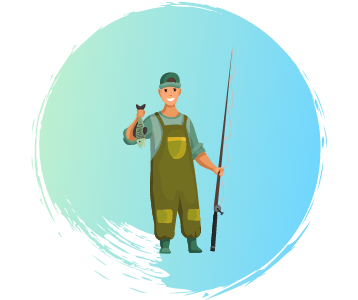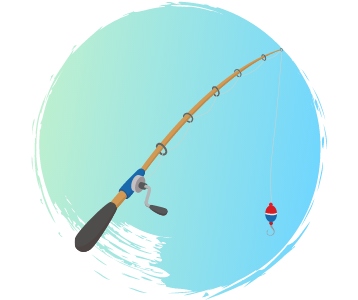Surf fishing is one of the most fun and accessible types of fishing you can learn. All you need is a few pieces of gear, a beach, and a little knowledge. But it can also be frustrating if you don’t know what to expect and don’t know a few essential tricks to help you find fish.
So we listed important pointers that we think will be helpful for you based on our years of experience.
Chapter 1
The Basics of Surf Fishing
Essentially, surf fishing is just fishing from a beach in the surf zone.
Some guys go out with a ten-dollar combo, stand chest-deep, and wait on bites. Others have hundreds of dollars in the equipment they drag out every time.
The simple definition of surf fishing means you can experience it in a way that suits you, and all you need to up your chances are some knowledge.
What You Need to Know to Get Started
You’ll want to know what kind of fish are in your area, what kind of bait is working, where to cast your line (more on that in a later section), and what kind of gear fits your fishing style.
For surf fishing, some things are rather widespread smart choices. For instance, some baits are a reasonable choice no matter where in the world you are. Shrimp and freshly caught baitfish are likely to get some attention from any number of species.
Longer rods have a better casting range than short ones, and ten to twelve-foot rods are pretty standard for surf fishing. However, in some places, you’re going to have the best success getting your bait a hundred yards from the sand, and to do that, you’re either getting wet or need tremendous casting distance.
When you boil it down, surf fishing itself is easy. You choose a good bait, cast it to a good spot, and then wait on your rod tip to begin jerking. Knowing which bait is best for any given fish species, where to cast your bait, and how to be more successful is all a matter of experience and knowledge. We’ll go over a lot of that as we go further into the article.
Chapter 2
What to Expect
We need to get a few things out of the way expectation-wise, so you know exactly what you’re getting into with surf fishing. It’s an excellent way to avoid disappointment and lets you be more prepared for what you’ll experience.
What You won’t Catch
Unless you’re in Hawaii on a volcanic rock or fishing from a barely protruding seamount, you aren’t going to catch any big offshore aquatic species from the beach. You might get some tuna, but it’ll be Bonita, not bluefin.
You won’t go out and catch thirty (insert your target species here) every trip. Sometimes you might have days where you only get a few nibbles or some catfish and whiting, especially if you aren’t actively moving to better spots around the beach.
What can Happen
None of that means you can’t end up in fierce battles with monster fish. Some of the most challenging fighting fish I’ve fought were hooked in the surf. They just happened to be sharks, bull redfish, and 6-foot wide stingrays instead of a tuna or marlin. You’ll have days where every cast catches a fish, or you’ll catch something tasty for dinner. Like with any fishing, you have to use your head and work for it if you want results.
Before you go out, you should temper your expectations. If you want to target a species, you should research how to target it. If you’re going to have a peaceful day and catch a few fish, then you can throw a line just about anywhere. It’s important to decide what you want out of the surf before going out, so you can have a much more enjoyable day.
Chapter 3
Reading the Surf
You can honestly find success just pulling up anywhere you want on a beach, plopping yourself down, and waiting for a bite. This kind of approach, while easy, is more of a feast or famine approach.
You might get lucky and plant your bait right in a busy fish highway, but you also might end up being in a dead zone. We’ll go over a few tips to help you read where you’ll find more fish and what to look for.
Where to Fish
The best places to fish on the beach are the inside and outside troughs of the sandbars, cuts in the sandbars, the middle of rip currents, and potholes. These are high-traffic areas for fish, whether it’s a place they tend to spend time like a pothole or their typical travel route like a cut in a sandbar.
Fish tend to use the sandbars as highways, swimming up and down the beach in the deeper troughs to either side. Cuts in the sandbar are easy to access to the waterways inside the bar and see many fish swim through.
Predator fish will also sit in deeper bowl-shaped holes in the sand and wait for baitfish to be washed into them. Nearly all fish take advantage of currents and tides to wait for prey to be swept by them, making rip currents a great place to look for fish.
What to Look for
For the most part, identifying the sandbar and its troughs is pretty easy. I recommend a good pair of polarized glasses since they make seeing objects under the water much easier. Even if it’s deep, the sandbar off your beach is going to be a lighter color than the darker water surrounding it. So you’ll want to cast into the darker water as near to the lighter colors as possible.
On the off chance, you can’t visibly see a sandbar, watch where the waves begin to gain height and topple over. This is because the start of the sandbar is higher than the seafloor the wave has been traveling over, causing it to start breaking (which you can identify by it seems to rise and foam along its top.
You should be able to see cuts in a sandbar as well. However, if you can’t, you can find them by watching water currents. When waves come together and seem to meet in the middle, sloshing into one another to become one, that’s one good indicator of an outwards sucking current (or rip current).
Chapter 4
Pro Tips for Surf Fishing
1. Fish with more than one rod.
In general, you want to get as many lines out as possible to get a good bait spread. This lets you fish in different zones (distances from the beach or spots) where fish are likely traveling so you can hone in on where they are.
The more lines you fish, the higher risk you run from tangling them if a bigger fish gets hooked and takes off. Typically two or three is sufficient for finding hot zones and is manageable even if big fish runoff.
2. Use a light drag.
Even if you’re fishing for pompano, whiting, or other smaller surf species, it’s best to keep your drag light when waiting on a bite. Big fish in the surf hit hard, and if your drag is locked down, they can snap your line on the take. Not only will you miss out on a good fight.
Sizeable redfish and sharks will run a good bit of line off your reel right after taking the bait. You could also lose the chance to get your leader back or remove your hook from a fish it could harm. It isn’t too uncommon for a sea turtle to grab a piece of squid on your hook, and the turtle should remove that hook.
3. Keep an extra rod on hand for casting lures.
You’ll likely be spending a lot of time sitting and waiting on a bite. Keep your eyes on the water up current if you know how fish tend to swim along the beach.
Schools of game fish like bluefish and jack crevalle will come by now and then, and if you spot them and are ready, you can get some great action by tossing a lure in front of the school. It’s also an excellent way to pass the time when you’re just waiting to give a spoon or sabiki a few throws and see if anything is interested in it.
4. Be mobile.
Some of the best fishing spots are farther away from crowds of tourists and parking lots. To find them, look for those cuts in the sandbar, riptides, and potholes that generally hold fish. If a spot isn’t producing, don’t just sit there and waste your time. Moving up and down the beach to find better spots will make your trip more enjoyable and successful.
5. Try a TON of baits.
There are a lot of common surf fishing baits like shrimp, squid, and sand fleas. These work great, but they might not always be the most effective option. Try to bring multiple kinds of bait with you, or catch small baitfish to use as well.
Fishing various kinds of baits go right along with using multiple rods to figure out where the fish are running. Here you’re just figuring out what the fish are most likely to bite on that day.
Chapter 5
Surf Fishing Gear Recommendations
Best Rods for Surf Fishing
Shakespeare TideWater 12 foot Heavy

Check Price on Amazon
The TideWater is my all-time favorite surf fishing rod. It’s pretty cheap, but it’s an absolute beast of a rod. The length and extra flex in its tip give you plenty of casting power, and with the right weight and practice can easily get your bait a hundred yards out. It’s also a strong enough rod to handle massive fish like those six-foot-wide stingrays and larger sharks.
Eventually, the ceramic eyes in the guides will fall out, but you’ll get a couple of thousand casts out of these rods before you run into any problems. The only weak point of the rod is the guides since the actual rod hasn’t ever failed me.
Fiblink Surf Spinning Fishing Rod

Check Price on Amazon
Alternatively, this Fiblink is another good choice in a surf rod. You can get a variety of sizes and styles for it, even getting a four-piece rod if you often travel or have trouble storing a 2-piece one. It has stainless steel guides, a comfortable handle wrap, and a light carbon fiber blank. It even comes with a year warranty for any defects.
Best Reel for Surf Fishing
Penn Spinfisher LongCast
If you want to get serious about casting distance and reel power, then this is the best reel you can get. The long cast spool is shallower and taller, allowing the line to come off the spool more smoothly without losing line capacity.
It casts a mile, is sealed against saltwater, and has tons of drag for reeling in monster fish. The 5500 will work great, though if you run into larger fish more often than not, go for the 7500 model.
Best Line for Surf Fishing
SpiderWire Stealth Braided Fishing Line

Check Price on Amazon
In my experience, you get more bang for your buck in the surf with a braided fishing line. If you play it correctly with your drag, you can land fish over 100 pounds with a thirty-pound line. This SpiderWire Stealth is an excellent choice since you can choose a color to match the water you’re fishing and reduce its visibility for the fish.
Chapter 6
Final Thoughts
When it comes to surf fishing, you generally get what you put in out of it. However, you need to use good knowledge to have the most success. After reading through this guide, you should have a decent understanding of surf fishing and get started. Remember that if something works for you, keep doing it, but don’t be afraid to experiment. Tight lines!

